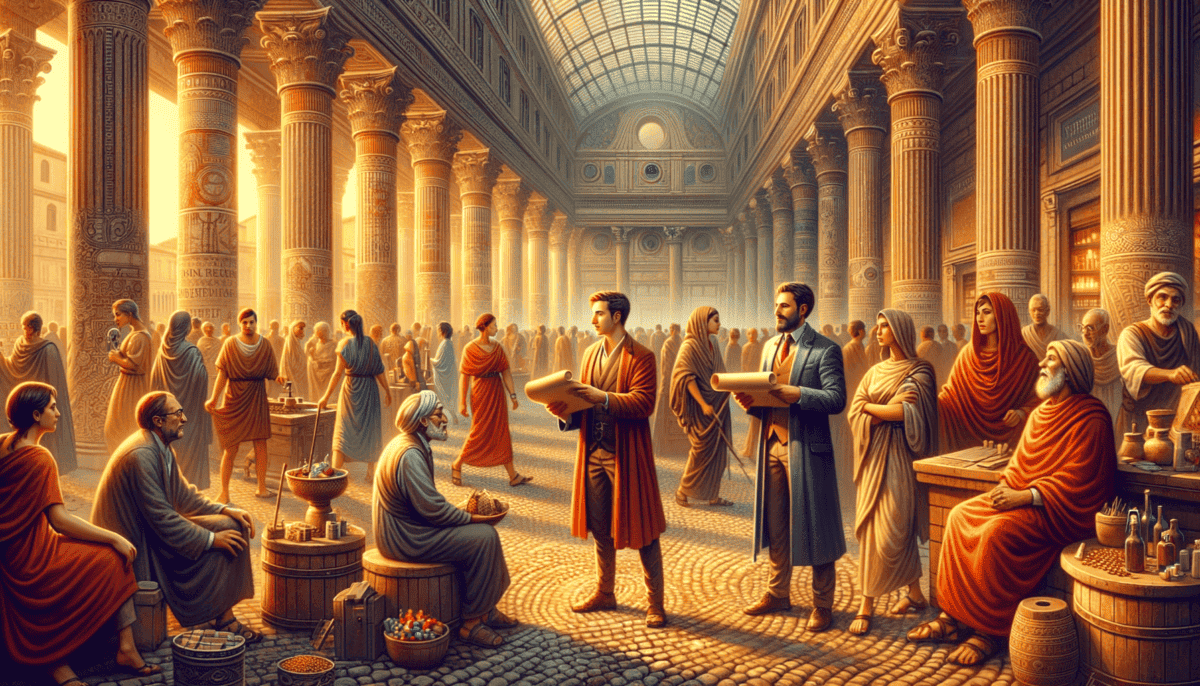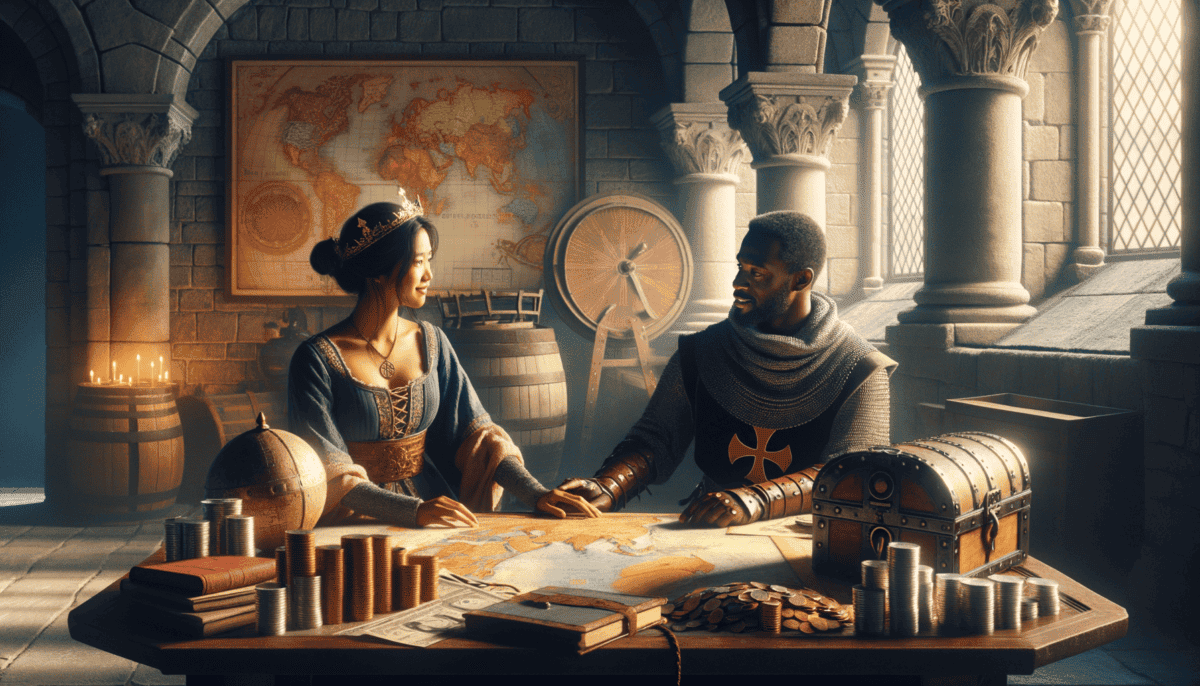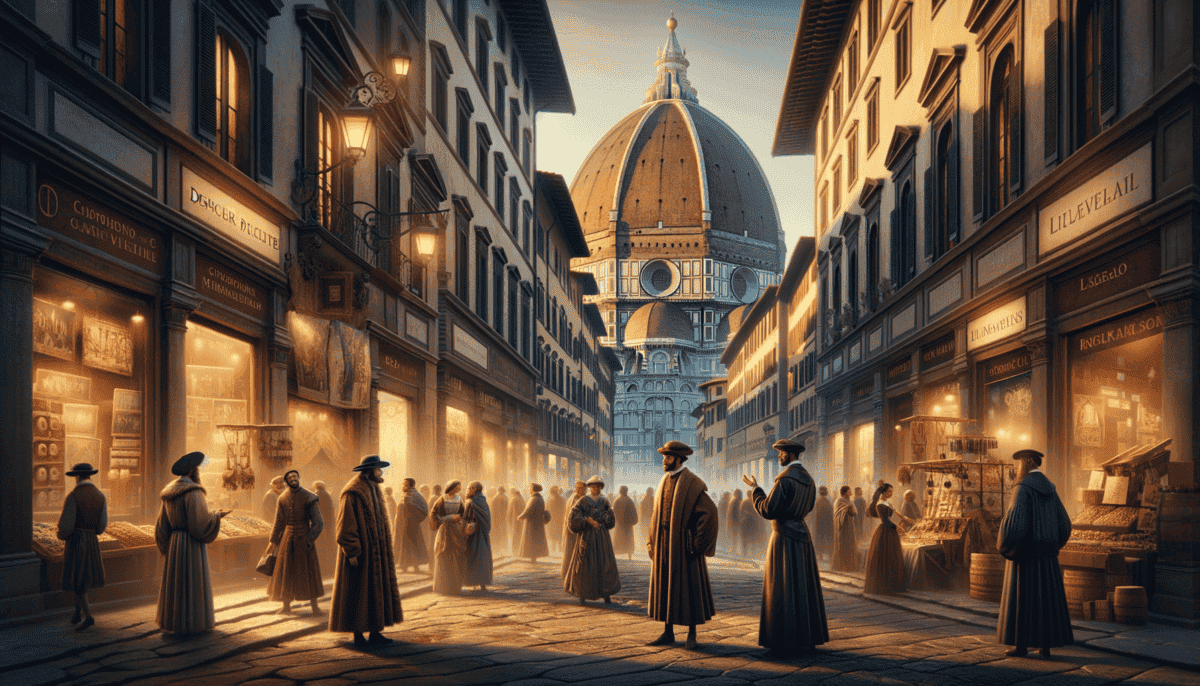The Clay Tablet Chronicles
️ Whoosh! A flash of bright light filled the air as Maya's time machine landed with a soft thud in ancient Mesopotamia. She stepped out, her special translator device hanging around her neck, and breathed in the dusty air of humanity's first cities.
"Time to solve the mystery of how people first started borrowing things," Maya whispered to herself, adjusting her detective hat. She was the world's first Time-Traveling Debt Detective, and she had an important case to crack.
A Journey to the First Cities
The bustling marketplace of Ur spread before her. The year was 3000 BCE, and the air was filled with the sounds of traders and farmers. Clay tablets were everywhere – the world's first receipts!
Maya watched as a farmer named Enlil approached a temple merchant. Their conversation caught her attention:
"I need grain for planting," Enlil said. "My family's food ran out before the harvest."
"We can help," the merchant replied, picking up a wet clay tablet. "You can borrow 10 baskets of grain. After harvest, you'll return 12 baskets."
Detective Maya’s Discovery
Maya crept closer, fascinated by what she saw. The merchant was using a reed stylus to press wedge-shaped marks into the clay – the world's first writing system called cuneiform.
"This is amazing!" Maya thought. "They're creating the first loan agreement in history!"
She watched as both men pressed their special cylinder seals into the wet clay – like signing a contract today. The tablet would be dried and kept safe as a record of their deal.
The Temple Treasury
Following the merchant, Maya sneaked into the grand temple. Her eyes widened at the sight of hundreds of clay tablets stored carefully on wooden shelves. Each one recorded a loan or payment.
"The first bank in history," she whispered in awe. The temples weren't just places of worship – they were the first financial centers! They kept track of:
• Grain loans to farmers
• Silver given to merchants
• Wool traded for copper
• Payments of workers
• Records of debts paid back
A Surprising Discovery
As the sun began to set, Maya made one final discovery. In a corner of the temple, she found a very special clay tablet. It showed that sometimes, when harvests were bad, the temple would forgive people's debts!
"They understood that being kind about debts helped everyone," Maya realized. "When people couldn't pay because of bad luck, giving them a fresh start kept the whole community strong."
The sky began to darken, and Maya knew it was time to head to her next destination. She had learned so much about how people first started borrowing and lending. As she climbed back into her time machine, she couldn't help but smile. The mystery of ancient debt was beginning to unravel, but there was still so much more to discover.
Maya punched in her next coordinates. The Roman Empire was calling, and she couldn't wait to see how money and lending would change in the next chapter of history. With another bright flash, she vanished into the time stream, ready for her next adventure.
Roman Banking and the Trust Revolution
️ Maya’s time machine materialized behind a grand marble column in the bustling Forum of ancient Rome. The year was 50 BCE, and the streets were alive with activity.
“Wow, this is so different from Mesopotamia!” Maya gasped, watching people hurry past in flowing togas. Instead of clay tablets, they carried small books made of wax tablets.
The Money-Changers’ Tables
At wooden tables called “mensae,” Maya saw money-changers at work. Their tables gave us our word “bank” – from “banca,” meaning bench!
She watched a merchant named Marcus approach a money-changer:
“I need to send money to my partner in Egypt,” Marcus explained.
“No need to carry heavy coins,” the banker smiled. “I’ll write you a letter of credit. My friend in Alexandria will give your partner the money when he shows this letter.”
The Trust Game
Maya noticed something special happening. People trusted these bankers with their money. The bankers kept the coins safe in strong rooms and gave out receipts.
A young boy asked his father, “Why do we trust them with our money?”
“Because they’ve shown they’re honest,” his father replied. “If they broke that trust, nobody would use them again.”
Banking Gets Bigger
Following the crowds, Maya found herself at a huge building – the first real bank! Inside, she saw:
• Record books tracking loans and deposits
• Secure vaults for storing gold and silver
• Busy clerks writing letters of credit
• Merchants planning trade routes
• People exchanging foreign coins
A Financial Mystery
Maya noticed something curious. Rich Romans were lending money to help build roads, temples, and ships. But they weren’t doing it alone – they formed groups to share the risk!
“Just like modern companies!” Maya realized. “They figured out that working together made big projects possible.”
– Saving accounts
– Business loans
– Money transfers
– Working together on big projects
The Great Fire Test
Suddenly, Maya heard shouts of “Fire!” in the distance. As people rushed to save their money, she saw something amazing. The Roman banks had fireproof strong rooms to keep people’s savings safe!
“They really thought of everything,” Maya smiled. “They knew keeping money safe meant keeping people’s trust.”
Time to Go
As the sun set behind the Capitoline Hill, Maya knew she had solved another piece of the money puzzle. The Romans had turned banking from simple loans into a system built on trust and teamwork.
She climbed back into her time machine, excited for her next stop. The medieval world was waiting, and she had heard exciting things about some special knights who became bankers!
Building trust
Writing things down carefully
Creating safe places for money
✉️ Making it easy to send money far away
Medieval Money and the Templar Connection
Maya’s time machine landed with a soft thud outside a massive stone castle. The year was 1180, and she had arrived in medieval France during the time of the Knights Templar.
“This place looks like something from a fairy tale!” Maya whispered, watching armored knights ride past on horseback.
The Warrior Bankers
Inside the castle, Maya met Brother Thomas, a Templar knight in a white robe with a red cross. He wasn’t fighting dragons – he was counting gold coins!
“Welcome, young traveler,” he smiled. “Are you here to store your valuables?”
A Safe Journey
Maya watched as a merchant approached Brother Thomas:
“I need to travel to Jerusalem,” the merchant said. “The roads are dangerous with robbers!”
“Fear not,” Brother Thomas replied. “Leave your money with us. Take this special paper. Our brothers in Jerusalem will give you your gold when you show it.”
Maya’s eyes lit up. “It’s like a medieval credit card!” she thought.
The Secret Network
The Templars had created something amazing – a network of safe houses across Europe and the Holy Land where people could:
• Store valuable items
• Get loans
• Exchange different kinds of money
• Travel safely with their wealth
• Send money to faraway places
Money Magic
Maya discovered the Templars had clever tricks to keep money safe:
“See these secret marks?” Brother Thomas showed her a document. “Only we know how to read them. It stops people from making fake papers.”
It reminded Maya of the security features on modern money!
A Royal Customer
Even kings used the Templars’ banks! Maya watched as King Philip of France arrived to borrow money for his castle.
“The Templars are trustworthy,” the king declared. “Their word is better than gold!”
The Code of Honor
Maya learned that the Templars had strict rules:
“We must always be honest,” Brother Thomas explained. “We never steal or lie. That’s why people trust us with their money.”
✨ Trust is precious
Working together helps everyone
Keeping money safe is important
Banking can connect the whole world
Treasure Maps
In the castle library, Maya found maps showing all the Templar banks across Europe and the Middle East.
“Just like modern bank branches!” she realized. “They were way ahead of their time!”
Moving Forward
As the castle bells rang for evening prayers, Maya knew it was time to go. The Templars had shown her how banking could help people travel and trade across the whole world.
Next stop: the colorful world of Renaissance Italy, where banking was about to become even more exciting! Maya couldn’t wait to meet the famous Medici family.
Renaissance and the Birth of Modern Finance
Maya’s time machine whirred to life, landing in a bustling square in Florence, Italy. The year was 1472, and the air buzzed with excitement of the Renaissance.
The Medici Welcome
“Benvenuta! Welcome!” called out Lorenzo de’ Medici, a young man in fancy clothes. “You’ve arrived at the perfect time. We’re making history with money!”
The Bank That Changed Everything
Lorenzo showed Maya around the Medici Bank. It was nothing like the stone castles of the Templars. This place had beautiful paintings on the walls and clever new tools for counting money.
“Look at this!” Lorenzo picked up a special book. “We write everything down in a new way called ‘double-entry bookkeeping.'”
Maya peeked at the neat rows of numbers. “It’s like having two copies to make sure everything matches!”
Trading Across the Seas
A merchant rushed in with exciting news:
“My ship just came in from India with spices!” he announced.
Lorenzo smiled. “No need to carry heavy bags of gold. We can use our bank notes instead!”
• Made banking beautiful and fun
• Created new ways to keep track of money
• Helped people trade across the world
• Turned Florence into a rich city
• Supported artists and scientists
Art Meets Money
Maya watched as Lorenzo paid a young artist named Leonardo da Vinci.
“The Medici believe in supporting creative people,” Lorenzo explained. “When we help artists and thinkers, everyone benefits!”
The Number Game
In a quiet room, Maya met a mathematician working on something new.
“We’re using numbers from India and the Arab world,” he explained. “It makes counting money much easier than Roman numerals!”
Family Secrets
Lorenzo shared some banking wisdom:
“Trust is everything in banking,” he said. “But we also need good math, smart plans, and brave ideas!”
Banking Gets Bigger
Maya saw how the Medici Bank had branches everywhere:
“We have banks in London, Lyon, and even Constantinople,” Lorenzo said proudly. “Money can now travel faster than horses!”
The Power of Paper
A new customer came in, worried about carrying gold on dangerous roads.
“Don’t worry,” Lorenzo smiled. “With our bank notes, your money is safe and easy to carry.”
✨ Banking can be beautiful
Money can support art and science
Good records keep money safe
Trade connects the whole world
A New Dawn
As the sun set over Florence’s red roofs, Maya knew she had seen something special. The Medici had turned banking into an art form and helped create our modern world of money.
But even bigger changes were coming. As her time machine powered up, Maya wondered what the Industrial Revolution would bring to the story of money and debt.
Industrial Revolution and Global Debt
Steam hissed and factory whistles blew as Maya’s time machine landed in London, 1812. The air was thick with smoke from countless chimneys.
A Different World
“Welcome to the age of machines!” called out James, a factory owner. “Everything’s changing faster than ever!”
Money Makes Machines
James showed Maya his cotton mill. Big machines spun cotton into thread.
“These machines cost lots of money,” James explained. “I had to borrow from the bank to buy them.”
“How do you pay it back?” Maya asked.
“The machines help us make more clothes to sell. Then we use that money to pay the bank!”
The Dark Side of Debt
Walking through London’s streets, Maya saw a gloomy building with bars on the windows.
“That’s the debtors’ prison,” whispered Sarah, a young worker. “People who can’t pay their debts get locked up there.”
Banks Get Bigger
Maya visited the Bank of England, now much grander than the Medici banks.
“We help the whole country borrow money,” explained Mr. Thompson, a banker. “Even the government needs loans for big projects!”
War and Money
A newspaper boy shouted headlines about war with France.
“Wars cost lots of money,” Mr. Thompson said. “Countries borrow huge amounts to pay for ships and soldiers.”
• Big machines needed big loans
• Banks grew much larger
• Countries borrowed more money
• New factories changed everything
• More people used banks
Working People’s Money
Maya met Emma, who worked in a factory.
“We get paid in cash now, not just food or housing,” Emma said. “And some workers even have savings accounts!”
Trains Change Everything
A steam train roared past, making Maya jump.
“Railways need huge amounts of money to build,” James explained. “But they help us move goods faster than ever!”
Global Money
At the docks, Maya watched ships from all over the world.
“London is the world’s money center now,” Mr. Thompson said proudly. “Our banks help people trade everywhere!”
Paper Promises
Maya noticed everyone using paper money instead of gold coins.
“The bank promises to pay in gold if you ask,” explained Mr. Thompson. “But paper is much easier to carry!”
✨ Machines changed how people worked
Banks became very powerful
Paper money became normal
Money connected the whole world
Looking Forward
As factory whistles marked the end of another working day, Maya knew the world of money would never be the same. The Industrial Revolution had created new ways to make, borrow, and use money.
Her time machine hummed to life. What amazing changes would the modern age bring to the story of money?
Digital Money and Tomorrow’s Treasures
Maya’s time machine glowed with colorful lights as she landed in today’s world. Everything looked so different from the smoky factories she just left!
A World of Plastic Money
“Look at this!” smiled Zara, showing Maya a small plastic card. “This is how most people pay for things now. It’s called a credit card!”
Phones That Pay
Maya watched as Alex bought coffee by tapping his phone on a small screen.
“Your phone can be your wallet now,” Alex explained. “It’s like magic!”
“But how does it work?” Maya asked.
“The money moves through the internet – like invisible messages between banks!”
Internet Banking
At a modern bank, Kim showed Maya her computer screen.
“I can check my money, pay bills, and send money to friends – all without leaving my desk!” Kim said.
• People bank on computers
• Phones work like wallets
• Cards replace cash
• Money moves at light speed
• Banking never sleeps
New Money Ideas
Maya learned about Bitcoin and digital coins.
“Some people think these might be the future of money,” explained Professor Chen. “They work without banks!”
Global Money Web
In a tall office building, Maya watched traders work with screens full of numbers.
“Money moves around the world in seconds now,” said trader James. “Everything is connected!”
Looking Back Through Time
Maya thought about her incredible journey through the history of money and debt:
“From clay tablets to credit cards,
From grain loans to global banks,
From Roman coins to digital money,
Every age brought new ways to trade and trust!”
The Future Beckons
Maya sat in a park, watching people tap and swipe their phones to pay.
“What will money look like in the future?” she wondered. “Maybe we’ll use starlight for shopping, or trade dreams for candy!”
✨ Money keeps changing
New ideas come all the time
The future holds more surprises
Trust still matters most
One Last Lesson
Before heading home, Maya wrote in her detective notebook:
“Money isn’t just coins or cards or numbers on a screen. It’s about people trusting each other and working together. That’s what makes it special – yesterday, today, and tomorrow!”
As her time machine powered up for the last time, Maya smiled. She had learned that while money changes shape, the story of people helping each other never ends. What exciting new chapters would tomorrow bring?






